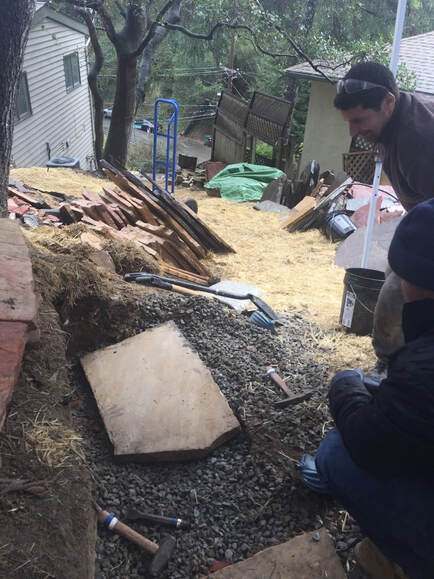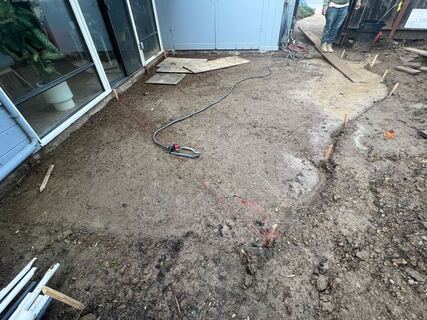Lithohydrology: The art and science of moving water through a landscape using dry laid stone work.5/17/2023 LITHOHYDROLOGY Harvesting water through the use of dry laid stone work Lithology-- Definition according to Merriam-Webster dictionary: the study of rocks the character of a rock formation Hydrology-- Definition according to Merriam-Webster dictionary: a science dealing with the properties, distribution, and circulation of water on and below the earth's surface and in the atmosphere A dry laid stone wall, with a built in bench. It’s all in the Design Understanding the way nature works is the guiding principle for our designs at Mariposa. Our design team considers multiple ways to replicate natural ecological systems in your garden. One of the ways we use our understanding of natural systems is through the designing and building of garden features out of stone. Our stone features are durable and they are also permeable. We do not use mortar to bind our stonework, rather we employ techniques to build walls, patios and paths that have been proven over centuries to be durable. Dry laid stone work allows water to move through stone structures. Our techniques with stone give us the ability to slow, spread and sink in our gardens to make sure that the water that falls in your garden, stays in your garden. In Mariposa gardens, we carefully move downspout water, through stones to water our gardens and replenish the ground water table. Water is a resource, not a waste source Conventional wisdom dictates that rainwater falling on a roof and property, must be removed away from the property in order to not cause damage to the house foundation. Most often, water is routed out into the street through downspouts from the roof and underground french drains. Downspouts and french drains channel rainwater to a point off of the property, most often routing it into the streets where the water gathers pollution before it enters a storm drain. Storm drain water eventually is delivered into an existing river or creek or into the Bay in the Bay Area. This water is not well suited for natural ecosystems as it introduces unwanted pollution. Constructing a base of drain rock with flagstones laid on end allows water to move from the downspout and out into the garden. Removing the water that would naturally fall on a property is a way of protecting a house from water damage. This action makes the water a source of waste that homeowners feel the need to protect their property from. However, especially during a drought, we see this water as a resource that can be used and stored on the property to keep the plants green and thriving. With thoughtful design and intentional building techniques, we use stones to move water away from foundations and keep it in the landscape. This is especially important to do in the drought to replenish the groundwater table. An empty "footer" ready for drain rock. Slow it, sink it, spread it At Mariposa we build stone features, such as walls, on a foundation filled with drain rock and decorative gravel. This feature is called a "footer" as it is at least one foot deep. A footer can slope in one direction or another, depending on how we want water to move in the landscape. This construction allows us to move, collect and store rainwater in the ground. The drain rock allows the water to gradually move under the ground, away from foundations, houses and other structures that may be damaged by water, slowly sinking into the soil as it goes. When we design our gardens, we are thinking about where to locate our stone features often based on how we want water to move through a property. A stone retaining wall that has just begun. The "footer" was filled with drain rock before the first stone was set on it. The same wall, completed. It holds up the hillside and allows for ample drainage. Grading the landscape with dry laid stone features We construct stone hardscape features such as dry stacked stone walls and dry laid paths and patios with natural construction methods that are both ecologically friendly and create ways to move water to where we want it in the landscape. Dry laid stone walls have “footers” which are essentially trenches filled with drain rock. Paths and patios are similarly constructed, in that they have a 6' base of drain rock and decorative gravel, allowing them to further slow, sink and spread water. A well graded patio area, just after the water test was done. Notice how water moves away from the house and into the planted area. The pan grade, which is the native soil after existing concrete or plants are removed, is graded by hand so that water flows away from the foundation of the house at a slope of at least 2%. Dry laid paths and patios are constructed on top of 3” of drain rock with 3” of decorative gravel above that. The drainage material under the flagstone helps to set the stones in place while allowing water to percolate into the rock and soil below at a rate that avoids puddling or flooding. The completed patio, prior to planting.
1 Comment
|
Categories
All
AuthorAndrea Hurd, founder of Mariposa Gardening & Design. Archives
June 2024
|
|
License #1038752
|
Mariposa Gardening & Design
Address: 2323 Broadway Oakland, CA 94612 Mailing Address: PO Box 24072 Oakland, CA 94623 [email protected] |










 RSS Feed
RSS Feed